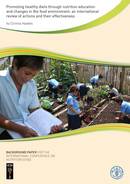Publications
The FAO has previously published a number of books and reports on topics relevant to ICN2, shown below, which can be used as background information for participants and stakeholders.
In the past two decades, child and maternal malnutrition has declined almost by half. Yet, child undernutrition and micronutrient deficiencies still impose the greatest nutrition related health burden at the global level. Undernutrition in children often results from poor quality diets in terms of variety, nutrient content and food safety...
The first International Conference on Nutrition (ICN) was held in Rome in jointly sponsored by the Food and Agriculture Organization (FAO) and the World Health Organization (WHO). A World Declaration and Plan of Action for Nutrition was adopted by delegates from 159 countries and the European Community who pledged to...
Consuming a healthy diet throughout the life-course helps prevent malnutrition in all its forms as well as a range of noncommunicable diseases (NCDs) and conditions. But increasing production of processed food, rapid urbanization and changing lifestyles have led to a shift in dietary patterns. People are consuming more foods high...
Overweight and obesity are leading risks for global deaths. Around 3.4 million adults die each year as a result of being overweight or obese. In addition, 44% of the diabetes burden, 23% of the ischaemic heart disease burden and between 7% and 41% of certain cancer burdens are attributable to...
According to the World Health Organization (WHO), of the 57 million global deaths in 2008, 36 million, or 63%, were due to non-communicable diseases (NCDs), principally ca rdiovascular diseases, diabetes, cancers and chronic respiratory diseases (WHO, 2011a). Nearly 80% of these deaths occur in low-and middle-income countries. Deaths from NCDs...




